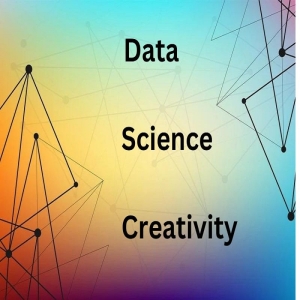Data science creativityPosted by Bhagat singh on May 4th, 2023  Introduction to Data Science CreativityData Science is an increasingly popular and important field of study that combines creativity, analytical thinking, and technology to solve complex problems. It’s no surprise then that Data Science creativity is a valuable skill for those with an interest in the field. But what exactly does “Data Science creativity” involve? This blog section will introduce you to the fundamentals of Data Science creativity and provide an overview of the key concepts needed for success. Creative Problem Solving is at the core of any successful data science project. Being able to come up with creative solutions and approaches to solving complex data problems allows data scientists to identify innovative ways to utilize data assets. This requires a combination of analytical thinking, exploration, and discovery, to develop meaningful insights from available data sets. Creative problem-solving also involves visualizing data to make it more legible and understandable — something which requires strong storytelling skills. At the heart of Data Science creativity is Analytical Thinking. This involves asking pertinent questions, evaluating facts, developing hypotheses, drawing conclusions, and validating results — all fundamental skills when working with data sets. Analytical Thinking allows for informed decision-making based on evidence-based reasoning; further enabling creative problem-solving by producing insights from collected information to form strategies or improve existing processes. Machine Learning Reviews Exploring the Different Types of Creative Data Science SolutionsOnce you understand your context and begin identifying creative approaches to data analysis, interpretation, and analysis become key components in designing an effective solution. Algorithms and models are used to analyze the data you’re working with which will then lead to uncovering any insights or trends within the dataset. Once these insights have been identified it’s important to look for ways of effectively visualizing them so that they can be understood more easily by anybody viewing them. Analyzing the Common Challenges of Creative Data Science ProjectsAnalyzing the project is just one step in the process. Understanding the scope of the task and what will be required to complete it is paramount. This includes data collection, solution development, communication, and resource allocation. All these elements must be taken into account when planning a creative data science project. Data collection is often one of the most difficult parts of a project, as there may be no existing datasets available. In this case, collection needs to be carried out from scratch or with minimal guidance from existing sources. This can prove challenging for teams whose members are not familiar with data science techniques or lack the skills needed to successfully collect large-scale datasets effectively. Data Science Reviews Once the necessary data has been collected, it’s essential to develop an appropriate solution to answer the questions arising from it. Depending on its complexity, this can require substantial trial and error testing as well as significant knowledge of software engineering methodology and industry standards for implementation. At this stage, efficient communication is key to ensure everyone involved has a shared understanding of what needs to be accomplished. Developing New Strategies for Achieving Creative ResultsData Science Creativity can be the key to developing innovative strategies for achieving successful results. Through brainstorming, an iterative process, and exploring unfamiliar ideas, data scientists can challenge assumptions and generate fresh concepts. Refining solutions for desired outcomes is also a critical step in this process. After formulating each strategy, it is important to test it thoroughly with prototyping and feedback elements as part of the process. Doing so will give data scientists the ability to evaluate their results and refine their strategies accordingly. If you are looking to develop new strategies for achieving creative results with your data science projects, then consider these steps: 1) Brainstorm potential ideas Brainstorming helps generate a wide range of possibilities that could potentially lead to creative results when properly implemented. 2) Iterate solutions – Working through solutions through an iterative process gives insights into how best to refine each solution or concept to arrive at desired outcomes. 3) Explore unfamiliar ideas – It’s important to explore unfamiliar ideas as they often can lead to unexpected yet effective solutions that can yield improved results 4) Challenge assumptions – Challenge existing assumptions by asking questions such as "What if?" or “How else can we look at this?” Doing so will prompt greater thinking beyond conventional wisdom. 5) Generate fresh concepts – Generate fresh concepts that incorporate data science from different angles to maximize chances of success. 6) Refine solutions for desired outcomes. Identify what needs to be done to get from point A (concept/idea) to point B (desired result). This means understanding which steps must be taken and how resources should be allocated for maximum productivity. Implementing Effective Visualization Tactics in Data Science Projects Data Visualization – Data visualization allows for information to be displayed or represented graphically to provide users with a clearer understanding. This can include various types of charts, such as pie charts, bar graphs, and line charts, which help visualize and compare numbers or trends in data sets. Visuals also allow users to identify potential correlations that may not have been recognizable prior. Building Data Story – Crafting a compelling narrative is key when it comes to presenting information visually. Utilizing the right messaging can effectively guide an audience’s attention toward actionable insights. Creating an impactful data story involves knowing when and how specific visuals can work together harmoniously, creating meaning out of clutter and noise. Interactive Representation – Making visuals interactive can bring tremendous value as it allows users to explore information at their own pace by zooming in and out on different parts of a chart or graph — a feature that’s especially helpful when dealing with complex datasets with various dimensions. Additionally, interactive representation enables users to test their hypotheses quickly with minimal effort. AI reviews Understanding the Database Tools Available for Enhancing Creativity in Data ScienceDatabase tools are essential for data scientists to properly manipulate and analyze their data sets. These tools enable data scientists to visualize their datasets in different ways, which helps them understand their data better. Database manipulation also allows for more sophisticated analysis of the data set. Scripting languages enable the user to automate certain tasks, making it easier and faster to manipulate large amounts of data. Enhancing creativity in data science also requires understanding machine learning and artificial intelligence (AI). Machine learning allows computers to learn from existing datasets without explicitly programming them to do so. AI enables machines to reason with complex problems quicker and more accurately than humans can. Machine learning is great for finding patterns within datasets that humans would not be able to see. AI can then use these patterns to make predictions or decisions on a larger scale than what a human could do alone. Data science is ultimately about being creative with the information available and finding innovative solutions that may have previously been inaccessible due to limitations in our knowledge or understanding of the topic. Understanding the different database tools available will help you unlock deeper insights into your datasets by providing you with more powerful analysis options, as well as more efficient means of manipulating your data. Utilizing machine learning and AI can also help you derive far greater value from your datasets than would be possible by yourself, resulting in exciting new opportunities for creative solutions involving large-scale datasets that would have been impossible before now. Utilizing Cutting-Edge Technologies to Enhance Data Science CreativityBy utilizing the latest tools available, data scientists can visualize their data sets to gain new insights that would have previously been lost in raw datasets. AI/machine learning applications allow for more efficient analysis without compromising accuracy. Automation tools help to lighten the workload for data scientists so they can focus on more creative tasks rather than mundane chores such as manual inputting of data. Cloud computing technologies make it easier for businesses to store and access their datasets from anywhere at any time, allowing for faster workflow when necessary. Robot process automation (RPA) has revolutionized the way businesses can automate tasks and processes. With RPA, companies can automate not only their tedious manual tasks but also more complex business processes with ease. Natural language processing (NLP) allows computers to understand human language and use this understanding to interpret customer queries and conversations accurately no matter the context or language used. Leverage The Power Of Data Science With Creativity To Generate Incredible ResultsData science provides the analytical capability to extract meaningful information from large datasets (Big Data) and use it for making strategic decisions. It also helps businesses to become more agile, responsive, and efficient by providing accurate insights into customer behavior and trends. With data science, you can gain a better understanding of customer needs, craft tailored strategies to maximize success, anticipate future opportunities and develop strategies that enable faster decision-making. Reviews Creativity brings its own unique set of benefits when used in conjunction with data science. Creativity is an essential part of problem-solving and offers an organic approach to formulating solutions. Creative thinking allows your organization to explore multiple perspectives on any given issue which can lead to innovative solutions that can be employed with data science to make smarter strategic decisions. In addition, creative thinking gives you access to a wealth of ideas that can be tested in real-world situations with the help of data analytics.
Like it? Share it!More by this author |


